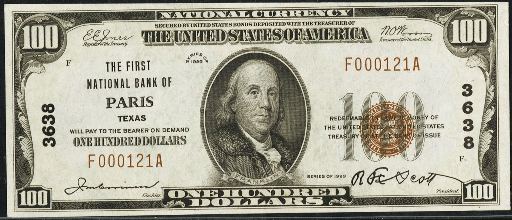The National Bank Of Smyrna
The National Bank Of Smyrna in Delaware printed $1,829,700 dollars worth of national currency. Over $1,000,000 face value is a lot of money. However, some types and denominations of currency from this bank could still be rare. This national bank opened in 1878 and stopped printing money in 1935, which equals a 58 year printing period. That is considering a long operation period for a national bank. During its life, The National Bank Of Smyrna issued 18 different types and denominations of national currency. We have examples of the types listed below. Your bank note should look similar. Just the bank name will be different. For the record, The National Bank Of Smyrna was located in Kent County. It was assigned charter number 2381.
We buy all national currency. Please call or email us for a quote. Sales@AntiqueMoney.com
The National Bank Of Smyrna in Delaware issued 3,000 sheets of $5 series of 1875 national bank notes. Hundreds of banks had sheet outputs between 2,500 and 5,000. That is pretty typical for a medium sized national bank in the 1870s. Series of 1875 $5 bills are some of the most commonly encountered bank notes from the first charter series. Only the original series $1 bill is more available. Some banks exclusively issued five dollar bills. So if you want an example from one of those banks then you don’t have many options. These notes have a rounded red seal and red serial numbers. They also all have a red charter number.
Series of 1875 $5 National Bank Note
The National Bank Of Smyrna printed 4,741 sheets of $10 series of 1875 national bank notes. Hundreds of banks had sheet outputs between 2,500 and 5,000. That is pretty typical for a medium sized national bank in the 1870s. The two vignettes seen on 1875 $10 bank notes are “Franklin and Electricity” and “America Seizing Lightning”. These notes occasionally confuse novices because the year 1752 is printed on them. That is when Benjamin Franklin discovered electricity. It has nothing to do with when these bank notes were issued. The back of each $10 bill has “DeSoto Discovering the Mississippi.”
Series of 1875 $10 National Bank Note
The National Bank Of Smyrna also printed 4,741 sheets of $20 series of 1875 national bank notes. The exact number of series of 1875 $20 national bank notes printed by this bank is good to know. Don’t expect a high number to lower the value or a small number to increase the value. These notes are scarce enough on their own that the stats don’t really matter. Twenty dollars was a lot of money between 1875 and 1901, which is the time period in which these were printed. These just weren’t saved in high numbers.
Series of 1875 $20 National Bank Note
The National Bank Of Smyrna also printed 5,020 sheets of $10 1882 brown back national bank notes. A print range between 5,000 and 10,000 suggests that there should be at least a couple of notes known to exist. There were three $10 bills printed on a single sheet of 1882 brown backs. The design of the bill is similar to all earlier ten dollar national bank notes. The nickname comes from the fact that these bills have a brown seal and brown overprint. Despite saying series of 1882, these were actually printed by some banks up until 1908. The date you see in cursive relates to when the bank first started issuing brown back notes.
Series of 1882 $10 Brown Back
The National Bank Of Smyrna also printed 5,020 sheets of $20 1882 brown back national bank notes. As you can see, the sheet output is the same for $20 brown backs as it is for $10 brown backs. There was only one $20 brown back printed on a sheet. So the sheet output also equals the total note output. One neat thing about all brown backs is that they each have a different back design based on which state issued them. The back left hand side of the note shows the state seal of which ever state the national bank was located in. Generally speaking, 1882 $20 brown backs are pretty difficult to locate. They typically were printed in small numbers and they don’t have a great survival rate.
Series of 1882 $20 Brown Back
The National Bank Of Smyrna also printed 1,274 sheets of $50 1882 brown back national bank notes. Not many banks printed $50 1882 brown backs. Sheet outputs aren’t extremely important. However, it is good factual information to know. The most common 1882 $50 brown backs are worth about $5,000. However, some can be worth more than $10,000 based on condition, serial number, and bank of issue.
Series of 1882 $50 Brown Back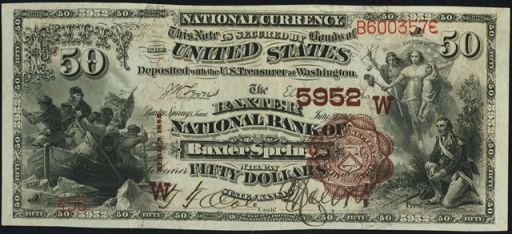
The National Bank Of Smyrna also printed 1,274 sheets of $100 1882 brown back national bank notes. Just because this bank printed more than 1,000 one hundred dollar brown backs does not mean that they are all common. We are very interested in purchasing $100 1882 brown back national bank notes. We have paid more than $15,000 for some examples. Send us pictures of what you have and we will respond quickly with an appraisal and offer.
Series of 1882 $100 Brown Back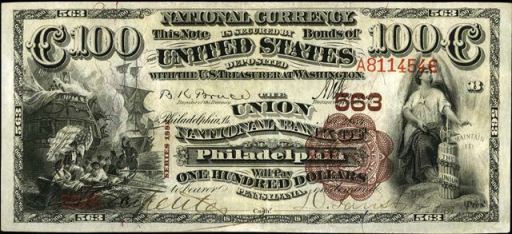
The National Bank Of Smyrna also printed 4,104 sheets of $10 1882 blue seal national bank notes. That is a pretty standard sheet output number for these issues. Most of the value is going to be in the condition. All of these notes say series of 1882 but they were actually printed between 1908 and 1921. So they aren’t quite as old as the dates might suggest. There is also a date on these notes that is between 1888 and 1901. That date is written in cursive text and it represents when the bank was chartered or re-chartered. Some of the so called 1882 value back notes have a chance to be really rare. Most of the earlier notes that say 1882-1908 on the back are likely going to be relatively common. The designs are exactly the same on the front. Each has a blue seal and charter number.
1882 Blue Seal $10 National Bank Note
The National Bank Of Smyrna also printed 4,104 sheets of $20 1882 blue seal national bank notes. That is the same number of sheets as the ten dollar denomination. You don’t have to multiply by three to get the exact number of notes issued though. There was only one twenty dollar bill per sheet. As with any national bank note, the exact value is still based on the condition, serial number, and bank of issue.
1882 Blue Seal $20 National Bank Note
The National Bank Of Smyrna also printed 768 sheets of $50 1882 blue seal national bank notes. High denomination 1882 blue seals like this are not frequently encountered, regardless of the number of notes printed. There is a big difference between the two types of 1882 $50 blue seals. The variety that says “1882-1908” on the back is rare, but no where near as rare at the type that says “Fifty Dollars.” The second variety is extremely rare and only about a half dozen are known to exist. The first type should still be worth at least $4,000. The second type is a five figure rarity though.
1882 Blue Seal $50 National Bank Note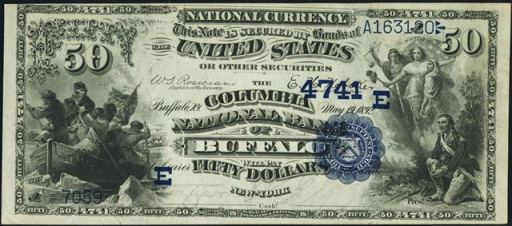
The National Bank Of Smyrna also printed 768 sheets of $100 1882 blue seal national bank notes. The number of sheets printed doesn’t matter too much here. All 1882 $100 blue seals are rare. They were issued by a total of 256 total national banks in the country. The rare 1882 value backs were only printed by banks in Dayton, Ohio and New Orleans, Louisiana. The slightly more common date backs are much more plentiful but still rare in the scheme of things.
1882 Blue Seal $100 National Bank Note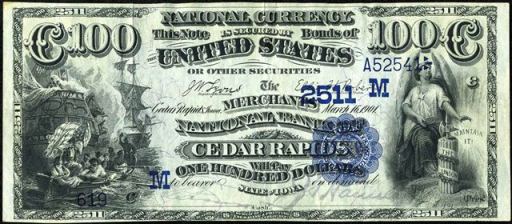
The National Bank Of Smyrna also printed 1,781 sheets of $50 1902 blue seal national bank notes. There is no trick to knowing which 1902 blue seals will be common and rare. Often times the number printed won’t tell you much information. The value still comes down to condition and demand. That is a surprise to most people. In fact, most 1902 $50 bills we see are worth between $750 and $1,250. The rarer ones can be worth more than $5,000. However, there isn’t much middle ground.
1902 $50 Blue Seal National Bank Note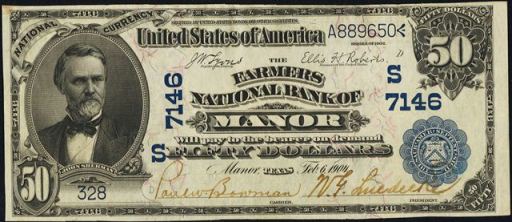
The National Bank Of Smyrna also printed 1,781 sheets of $100 1902 blue seal national bank notes. It is no coincidence that the sheet numbers for $50 bills and $100 bills are the same. They were printed on the same sheets. Most $100 blue seals are at least scarce; others can be very rare. John J Knox is printed on the front of each bill. Most collectors like the back design a lot more though. It is really unique and different from most other national bank notes. Prices for 1902 $100 blue seals are pretty similar to $50 blue seals. They are both equally common or equally rare, depending on how you look at it.
1902 $100 Blue Seal National Bank Note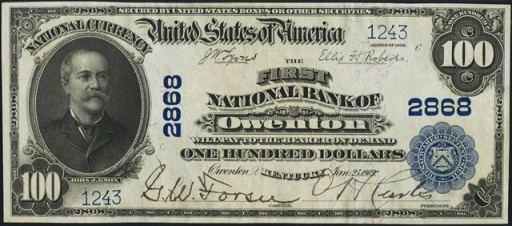
The National Bank Of Smyrna also printed 962 sheets of Type1 1929 $5 national bank notes. This is a small print range, but it does not guarantee rarity. Every 1929 $5 bill has a portrait of Abraham Lincoln on it. This is also the lowest denomination of small size national currency that any bank issued. All serial numbers end with the letter A and start with a letter between A and F. Remember that you can take the total number of sheets printed and multiply it by six get to the actual number of bank notes printed for this denomination. All small size national bank notes were printed on sheets of six.
Series of 1929 Type1 $5 National Bank Note
The National Bank Of Smyrna also printed 720 sheets of Type1 1929 $10 national bank notes. This is a small print range, but it does not guarantee rarity. Each $10 bill from 1929 has a portrait of Alexander Hamilton on it. The black number written vertically is the charter number. The charter number never affects the value; it is just an identifier. The ten dollar type1 national bank note happens to be the single most common national bank note, with over 65,000 known to exist from all banks. Of course each note is valued based on its condition and rarity. Some are very rare.
Series of 1929 Type1 $10 National Bank Note
The National Bank Of Smyrna also printed 222 sheets of Type1 1929 $20 national bank notes. That may sound like a very small number, and it is. However, when it comes to small size notes, that print range usually allows for a handful of survivors. Andrew Jackson is featured on the front of each 1929 $20 bill. Be sure to take note of the serial number on your specific bank note. If it is 000001 then you can expect a nice premium. There is a special market for serial number one bank notes. Of course, even if the number isn’t #1, it could still be collectible and have a high value just based on its condition and rarity alone.
Series of 1929 Type1 $20 National Bank Note
The National Bank Of Smyrna also printed 250 sheets of Type1 1929 $50 national bank notes. That may sound like a very small number, and it is. However, when it comes to small size notes, that print range usually allows for a handful of survivors. As is the case with all modern fifty dollar bills, Ulysses Grant is pictured on the front of 1929 $50 bills. This is a higher denomination that was only printed by 300 different national banks. Many examples are only worth around a few hundred dollars. Rarer specimens can sell for more than $1,000.
Series of 1929 Type1 $50 National Bank Note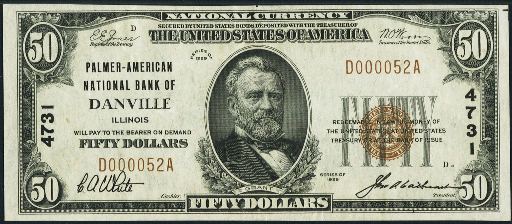
The National Bank Of Smyrna also printed 84 sheets of Type1 1929 $100 national bank notes. That is an extremely small sheet printing number. Survivors are still likely but definitely not guaranteed. Despite saying series of 1929, all type1 national bank notes were actually printed between 1929 and 1933. Exactly 289 national banks printed $100 type1 notes. Most are relatively common. However, as with anything, there are always exceptions to that rule.
Series of 1929 Type1 $100 National Bank Note